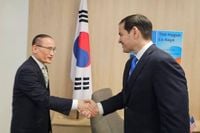In the wake of the recent NATO summit in The Hague, U.S. President Donald Trump has successfully pushed NATO allies to commit to increasing their defense spending to 5% of GDP by 2035. This bold move has sparked speculation that Trump will seek similar commitments from Asian allies, notably South Korea, which is now navigating complex discussions over its defense budget and alliance commitments.
Following the summit on June 25, 2025, President Trump, alongside U.S. Secretary of Defense Pete Hegseth, emphasized the importance of burden-sharing among allies. While NATO members agreed to this significant increase, the implications for South Korea are unfolding amid working-level talks between Seoul and Washington.
On June 26, National Security Adviser Wi Sung-lac confirmed that South Korea has received a formal request from the U.S. to increase its defense spending, mirroring the NATO benchmark. "The U.S. is making similar requests to several allies, just as it did with NATO," Wi stated during a briefing after returning from the summit. "South Korea has also received such a request, and working-level discussions are underway. These issues are currently being reviewed through security consultations." These conversations are expected to shape the agenda for the upcoming summit between South Korean President Lee Jae Myung and President Trump.
Currently, South Korea allocates about 2.3% of its GDP to defense—the highest among U.S. allies—compared to roughly 1% by Japan and NATO countries. Despite this, experts express skepticism over Seoul's ability to meet the 5% GDP target. Kim Jung-sup, a senior research fellow at the Sejong Institute, pointed out that the European context driving NATO's decision does not neatly apply to South Korea. "Instead of matching the percentage that the U.S. demands, we need to clearly state that South Korea will take responsibility for addressing North Korea’s conventional military capabilities and strengthen its defense capabilities for doing so," Kim advised.
Moreover, the U.S. demand extends beyond simply increasing defense spending. Washington is pressing Seoul to cover costs associated with the deployment of U.S. strategic weapons and participation in military drills outside the Korean Peninsula—expenses not currently included under the Special Measures Agreement (SMA). The SMA, which governs South Korea’s contributions to the U.S. Forces Korea (USFK), traditionally covers construction, logistical support, and labor expenses. Joseph Yun, the U.S. chargé d'affaires ad interim in Seoul, explained during a discussion on June 24 that "there needs to be discussion about how to share expense beyond those three categories, and whether Korea is spending enough on defense." This signals a push for a more expansive cost-sharing framework, which some view as a radical shift.
Such demands have stirred opposition among South Korean experts. Kim Jung-sup cautioned, "If South Korea is going to pay for the deployment of strategic assets, that would warrant a revision of the current SMA, so it would be impossible to enact immediately." Cho Seong-ryoul, a visiting professor of military studies at Kyungnam University, echoed this sentiment, arguing that instead of increasing shares in defense spending, South Korea should focus on strengthening its own defense industry and capabilities.
South Korea’s defense budget is already substantial, surpassing 60 trillion won (approximately $44 billion) in 2023. According to the country’s midterm defense plan, this budget is expected to grow by an average of 7% annually, reaching around 80 trillion won by 2028—about 3% of GDP—and exceeding 100 trillion won in the early 2030s. Officials are considering how to allocate the remaining gap to meet the 5% target, potentially through indirect investments in basic science, education, critical infrastructure, and expanded research and development in military technologies. This aligns with South Korea’s ambition to become one of the world’s top four defense exporters.
Park Ihn-hwi, an international studies professor at Ewha Womans University, cautioned against simply accepting the 5% target at face value. "NATO members currently spend less than 2% of their GDP on defense, while Korea is already contributing more," he noted. "Even if the 5% rule is accepted, it would make more sense to focus on increasing R&D in areas related to emerging security threats such as Russia and the Middle East. That would maximize mutual benefits."
Further complicating the issue, the U.S. is also seeking to link defense spending discussions with broader trade and tariff negotiations. Wi Sung-lac revealed that during his trip to the Netherlands, he met with U.S. Secretary of State and National Security Adviser Marco Rubio, and both agreed on the urgency of holding a summit between Presidents Lee and Trump soon. "We are currently in discussions on trade and security matters," Wi said. "There is shared understanding that these talks should be consolidated to prepare for a successful summit." This suggests that tariffs and defense spending will be the two main agenda items, potentially intertwined in the broader management of the U.S.-South Korea alliance.
South Korea’s response to the U.S. demands remains measured. A Foreign Ministry official stated on June 26 that Korea would "work closely with the U.S. to ensure that the South Korea-U.S. alliance evolves into a ‘comprehensive future-oriented strategic alliance’ to combat the rapidly changing economic and security environment." However, when pressed for specifics about ongoing talks on increased defense spending, the official remained circumspect, emphasizing that the two nations are "constantly communicating at all levels to strengthen the alliance."
Experts suggest that Seoul should approach the issue with flexibility, much like NATO’s gradual 10-year plan to reach the 5% target. Cho Seong-ryoul recommended integrating and coordinating defense expenditure items across various ministries to buy time and adapt strategically. This approach would allow South Korea to enhance its defense posture without rushing into unsustainable budget increases.
As the U.S. continues to push for greater burden-sharing among its allies, South Korea finds itself at a crossroads. Balancing the demands for increased defense spending and broader cost-sharing with the realities of its economic and security environment will require careful negotiation and strategic foresight. The upcoming summit between Presidents Lee and Trump will be a critical moment in defining the future of this key alliance amid shifting global security dynamics.




